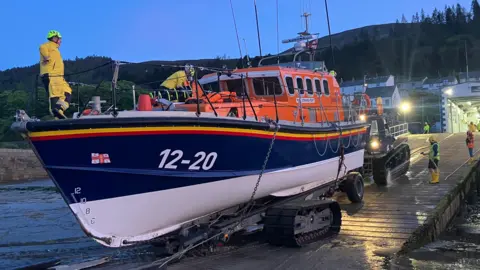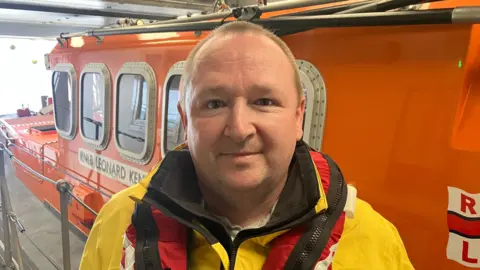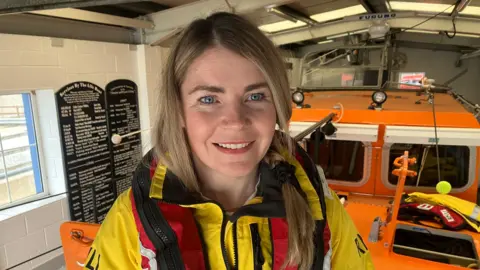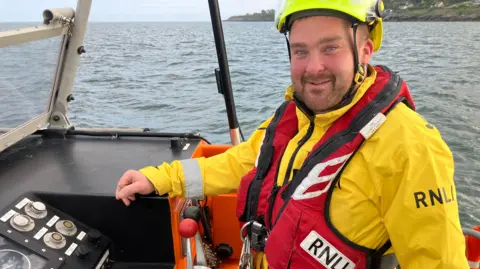'You have to be calm in a rescue operation' - RNLI volunteer
 BBC
BBCThe recent tragedies in Buncrana and Sligo where three schoolboys lost their lives, serves as a brutal reminder of the dangers of open water.
Last year, the Royal National Lifeboat Institution (RNLI) in Northern Ireland said it came to the aid of 469 people – 16 of those were deemed to have had their lives saved.
There are 46 RNLI stations across Ireland, strategically sited along the coastline and on major inland waterways. Ten of those are in Northern Ireland.
This year one of them, Newcastle, County Down, celebrates its 200th anniversary.
Like the rest of the RNLI fleet, Newcastle's iconic Mersey Class vessel (the Leonard Kent) will be retired and replaced by the faster, but smaller, Atlantic 85 at the end of this year.
In 2024 alone the Newcastle boat launched 18 times – helping 26 people and saving three lives.
For those rescued, it can be a life changing experience.

In August 1998, William Irvine went fishing with three friends on the rocks at Maggie's Leap just outside Newcastle.
After one of the group slipped into the water off the steep rocks, William took off his jumper and tried to use it as a rope.
"I tried to pull him in but I slipped on the fishing rods and fell in as well," he told BBC News NI.
"Then one of the others tried to bring me in by using one of the fishing rods but a wave took me out further and brought him in and the fourth one tried to climb up the rocks but he slipped and fell in."
During the ordeal, William lost consciousness.
"The next thing I remember was waking up on the lifeboat."

One of the rescue crew that day was Brendan Rooney, a full-time musician who is still on the lifeboat crew.
"When we went in the first time we got the first two lads onto the boat," he said.
"By then the Mersey Class boat had arrived so we transferred them onto the Mersey. On the second, we went back in but the Skeg hit a submerged rock on the way in, but luckily we got over it."
Throughout the years Brendan has been involved in dozens of rescues, adding: "Too many to remember".
What the sea throws at lifeboat teams when they respond to a call is different every time but the process of getting there remains constant.

After a 999 call comes in to the coast guard, the RNLI may be asked to launch a vessel.
Daniel Curran is the man responsible in Newcastle for making those decisions.
"We assess the situation and then the coastguard goes ahead and sounds the pagers", he explained.
"We make our way to the station as quickly as we can and everyone slots into their roles. And that's not just those on the boat; there's also an enormous number of people working as shore crew."

Caoimhe Connor got involved in rescue operations nearly a decade ago after witnessing a tragedy at a beach where she was surfing.
She's now the at the helm of one of Newcastle's boats, a role that requires a cool head in challenging circumstances, often late at night.
"You're jumping out of bed, half asleep. Even before I leave the house it's important to calm yourself down.
"You have to know that the adrenalin rush isn't a great thing. Then you get this sense of calmness because you know you have to focus on what it is you have to do."

Behind the wheel of the Mersey Class in Dundrum Bay is Niall McMurray - as the crew take part in one of their weekly training sessions.
"We've launched into Dundrum Bay and we're practicing different recovery techniques – in this case man overboard," he explained.
That 'man' is a life size and heavyweight mannequin who is unceremoniously dumped in the water and lost. The crew is tasked with finding him and bringing him to safety.
On return, many of the team's 40-strong volunteers are on hand to lift the Mersey out of the sea and bring casualties to safety.
A tractor-type machine on caterpillar wheels pulls the boat onto a large trailer on the shore, the vessel is washed down and taken back to the boathouse, ready for its next call.
It is a process that will change dramatically in the New Year with the retirement of the Mersey Class.
Newcastle received its first Mersey [The Eleanor and Bryant Girling] in 1992. In 2022, the Laurence Kent arrived having previously served in Margate and Poole.
In place of these boats will be the open-topped Atlantic 85.
Brendan Rooney says the Mersey can do 19 knots but the Atlantic can hit 35.
"We hope to get the training boat soon so we're looking forward to getting it in place," he said.
"It'll be different for us as we've never experienced it and it will benefit the area."
